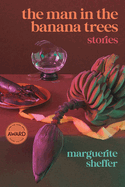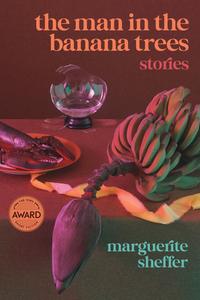
 Marguerite Sheffer won the Iowa Short Fiction Award for her inventive debut collection, The Man in the Banana Trees. Technology and art are major themes and the 18 short stories, half of which are flash length, incorporate speculative elements to explore how the past--and the dead--might persist.
Marguerite Sheffer won the Iowa Short Fiction Award for her inventive debut collection, The Man in the Banana Trees. Technology and art are major themes and the 18 short stories, half of which are flash length, incorporate speculative elements to explore how the past--and the dead--might persist.
Sheffer draws on history or envisions an alarming near-future--or both within four pages, as in "The Unicorn in Captivity," which strings together moments in the life of a tapestry from a French chateau. In 2073, the "children of the sunken city," viewing it behind plexiglass, marvel more at the background foliage than the legendary creature.
Art also lives on in two other standouts. In "En plein air," the ghost of a painter haunts a corporate retreat on a Southern barrier island and fumes when she learns that her Black "house girl," Josephine, painted over her discarded canvases with everyday scenes of island life. In "In the Style of Miriam Ackerman," a photographer's posthumous exhibit is augmented with disturbing AI-generated projections.
Technology and creativity can be at odds or go hand in hand. "At the Moment of Condensation" features drones in a teardrop formation carrying upturned umbrellas to collect water. In a drought-ridden future where corporations monopolize airspace to harvest rain, the act is both protest and performance art. Climate breakdown is also the backdrop to "The Pantheon of Flavors," when the keynote address at the International Ice Cream Technology Conference 2036 predicts burnt tastes will dominate in a world on fire.
Several stories are voiced by teachers contemplating their responsibility to a certain student--a puppet, a boy objecting to the status quo during a staging of The Nutcracker composed of "white Victorian children and... mostly Black and Latino mice," or a murdered Black teenager given a virtual reality memorial. In the title story, set in Covid-era New Orleans, a woman miscarries twins. Although this seems like one of the most realistic stories in the book, she imagines the title character, a Rumpelstiltskin-like imp, ushering in disasters. Here and elsewhere, Sheffer dabbles in magic realism and horror.
She also commemorates real figures: Josephine in "En plein air" was modeled on Clementine Hunter; Lizzie, the discoverer of pulsars in "The Observer's Cage," was inspired by Jocelyn Bell Burnell. Sheffer moves between time periods and genres with aplomb, exhibiting variety and verve. Her final paragraphs and lines, in particular, are killer. This terrific collection should attract fans of Megan Mayhew Bergman, Alexandra Chang, and Louisa Hall. --Rebecca Foster, freelance reviewer, proofreader and blogger at Bookish Beck
Shelf Talker: The 18 stories of Marguerite Sheffer's wonderfully inventive debut alternate between the realistic and the speculative, employing technology and art to explore how the past and the dead might live on.

